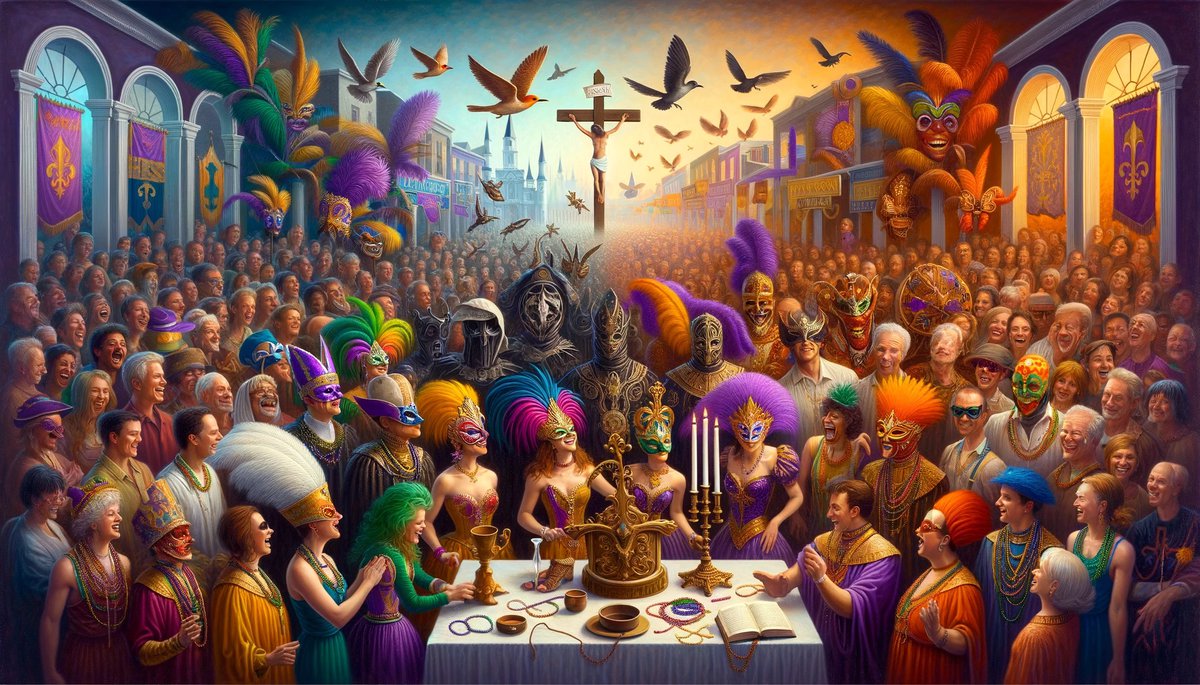Home>Special Themes>How Long Does Catholic Lent Last


Special Themes
How Long Does Catholic Lent Last
Published: February 27, 2024
Peter Smith, Editorial Director at Christian.net, combines deep insights into faith, politics, and culture to lead content creation that resonates widely. Awarded for his contributions to religious discourse, he previously headed a major organization for religious communicators, enhancing dialogue on faith's societal impacts.
Discover the duration of Catholic Lent and its significance. Explore the special themes and practices observed during this solemn period.
(Many of the links in this article redirect to a specific reviewed product. Your purchase of these products through affiliate links helps to generate commission for Christian.net, at no extra cost. Learn more)
Table of Contents
Introduction
So, you're curious about how long Catholic Lent lasts? Well, you've come to the right place! Lent is a significant period in the Catholic calendar, and it's natural to want to understand its duration and significance. In this article, we'll delve into the origins of Lent, the duration of this observance, its significance, and the practices associated with it. By the end, you'll have a comprehensive understanding of this important time in the Catholic faith. Let's get started!
Read more: When Does Lent Start For The Catholics
The Origins of Lent
-
Early Christian Practices: The origins of Lent can be traced back to the early Christian church. In the first few centuries, there was no set period for Lent, and the practices varied among different Christian communities.
-
40 Days Symbolism: The 40-day period of Lent is believed to have been inspired by the 40 days that Jesus spent fasting in the wilderness. This period of fasting and reflection became a significant part of the Christian tradition.
-
Council of Nicaea: It was not until the Council of Nicaea in 325 AD that there was an attempt to standardize the observance of Lent. The council discussed the proper time for celebrating Easter and the period of fasting that should precede it.
-
Preparation for Easter: Lent was established as a 40-day period of fasting and reflection, mirroring the 40 days that Jesus spent in the wilderness. It became a time for Christians to prepare themselves for the celebration of Easter, the most important event in the Christian calendar.
-
Penitential Season: Over time, Lent also became associated with penitence and self-examination. It was seen as a time for Christians to repent of their sins and renew their commitment to their faith.
-
Evolution of Practices: The specific practices associated with Lent, such as fasting, abstinence, and prayer, evolved over the centuries. Different regions and denominations developed their own traditions, but the core idea of a 40-day period of spiritual preparation remained constant.
-
Modern Observance: Today, Lent is observed by Catholics and many other Christian denominations around the world. It remains a time of fasting, prayer, and reflection, as well as a period of preparation for the joyous celebration of Easter.
Understanding the origins of Lent provides insight into the significance of this observance and the traditions that have developed around it.
The Duration of Lent
Lent typically lasts for 40 days, but the way this period is calculated might seem a bit confusing at first. Here's the breakdown:
-
Start of Lent: Lent begins on Ash Wednesday, which falls 46 days before Easter Sunday. This might seem contradictory to the 40-day duration, but the explanation lies in the way Sundays are treated during Lent.
-
Sundays During Lent: While Lent is traditionally considered a 40-day period, Sundays are not included in this count. Since Sundays are always regarded as a celebration of the resurrection of Jesus, they are not counted among the days of Lent. Therefore, if you exclude the six Sundays between Ash Wednesday and Easter Sunday, you'll arrive at the 40-day duration.
-
End of Lent: Lent concludes at sundown on Holy Thursday, which marks the beginning of the Easter Triduum – the three-day period leading up to Easter Sunday. This means that the Lenten season officially ends as the Triduum begins.
Understanding the duration of Lent helps to clarify why it is referred to as a 40-day observance, despite the calendar days not always aligning with this count.
The Significance of the 40 Days
The 40-day duration of Lent holds profound significance in the Catholic faith, symbolizing several key aspects of Christian belief and practice:
-
Biblical Symbolism: The number 40 has significant biblical symbolism, representing a period of testing, preparation, and transition. In the Old Testament, it rained for 40 days and 40 nights during the Great Flood, and Moses spent 40 days on Mount Sinai. In the New Testament, Jesus fasted for 40 days in the wilderness, facing temptation and preparing for His ministry.
-
Spiritual Preparation: The 40 days of Lent provide an opportunity for spiritual preparation and introspection. It is a time for Catholics to reflect on their lives, repent of their sins, and renew their commitment to their faith. The period of Lent encourages believers to emulate Jesus' withdrawal into the desert for prayer and fasting, seeking a deeper connection with God.
-
Fasting and Abstinence: The practice of fasting and abstaining from certain foods during Lent is a way for Catholics to participate in Jesus' sacrifice and demonstrate self-discipline. By voluntarily giving up indulgences, believers are reminded of the importance of spiritual nourishment and the sacrifices made by Jesus for the salvation of humanity.
-
Journey to Easter: Lent serves as a spiritual journey leading up to the celebration of Easter, the most significant event in the Christian calendar. The 40 days of Lent mirror the 40 days of Jesus' preparation in the wilderness, culminating in His triumph over temptation and the ultimate victory of His resurrection on Easter Sunday.
-
Renewal and Rebirth: The Lenten season is a time of renewal and rebirth, mirroring the themes of sacrifice, redemption, and new life central to the Christian faith. Through prayer, fasting, and acts of charity, Catholics seek to purify their hearts and minds, preparing to fully embrace the joy and hope of Easter.
The 40 days of Lent are a period of profound spiritual significance, inviting Catholics to engage in self-examination, prayer, and acts of compassion as they journey towards the celebration of the resurrection of Jesus.
Practices During Lent
During Lent, Catholics engage in various practices that are intended to foster spiritual growth, self-discipline, and reflection. These practices are deeply rooted in the traditions of the Catholic faith and serve as a means of preparing for the celebration of Easter. Here are some of the key practices observed during Lent:
-
Fasting: One of the central practices of Lent is fasting, which involves abstaining from certain foods or meals, particularly on Ash Wednesday and Good Friday. The act of fasting is a symbolic way for Catholics to share in the sacrifice of Jesus and to focus on spiritual nourishment rather than physical sustenance.
-
Abstinence: In addition to fasting, Catholics are called to abstain from meat on Ash Wednesday and all Fridays during Lent. This act of abstinence is a reminder of Jesus' sacrifice on the cross and serves as a form of self-discipline and solidarity with those who are less fortunate.
-
Prayer: Lent is a time for intensified prayer and spiritual reflection. Catholics are encouraged to devote more time to prayer, attending additional church services, participating in the Stations of the Cross, and engaging in personal prayer practices. This focus on prayer allows believers to deepen their relationship with God and seek guidance for their spiritual journey.
-
Almsgiving: Acts of charity and generosity are emphasized during Lent as a way of embodying the spirit of compassion and selflessness. Catholics are encouraged to give to those in need, whether through financial donations, volunteering, or other forms of assistance. Almsgiving is a tangible expression of love and solidarity with others, reflecting the teachings of Jesus on caring for the marginalized and vulnerable.
-
Lenten Devotions: Many Catholics take on specific devotions during Lent, such as reading spiritual literature, participating in retreats, or engaging in acts of self-denial. These devotional practices are designed to foster a deeper connection with God and a greater awareness of the significance of Lent in the life of faith.
-
Reconciliation: The sacrament of reconciliation, also known as confession, holds particular importance during Lent. Catholics are encouraged to engage in the sacrament as a means of seeking forgiveness for their sins, reconciling with God, and experiencing spiritual renewal.
These practices during Lent are intended to create a focused and intentional period of spiritual growth, self-examination, and preparation for the celebration of Easter. By engaging in these practices, Catholics seek to embody the values of their faith and deepen their commitment to living a life of compassion, humility, and devotion to God.
Read more: How Do Catholics Practice Lent?
Conclusion
In conclusion, the duration of Catholic Lent lasts for 40 days, beginning on Ash Wednesday and concluding at sundown on Holy Thursday. The 40-day period symbolizes the biblical significance of testing, preparation, and transition, mirroring Jesus' 40 days of fasting in the wilderness. Lent holds profound significance in the Catholic faith, serving as a time for spiritual preparation, self-discipline, and reflection in anticipation of the celebration of Easter. The practices observed during Lent, including fasting, abstinence, prayer, almsgiving, and reconciliation, are integral to fostering spiritual growth and deepening one's connection to the core values of the Christian faith. As Catholics engage in these practices, they seek to embody the teachings of Jesus, express compassion towards others, and renew their commitment to living a life of faith and devotion. Ultimately, the 40 days of Lent offer a transformative journey towards the joy and hope of Easter, encapsulating the core beliefs and values of the Catholic tradition.














